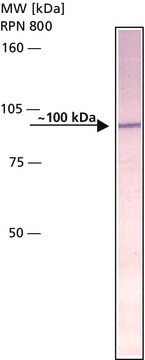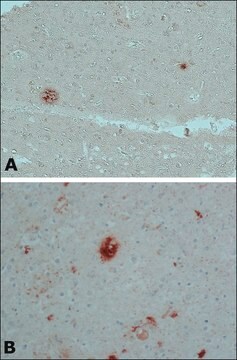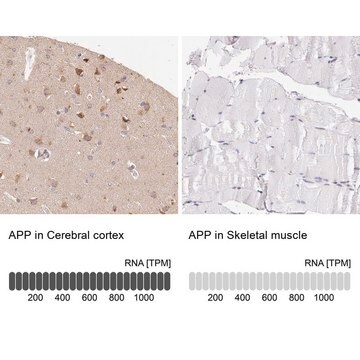AB1593
Anti-Amyloid Precursor Protein Antibody, a.a. 44-63
serum, Chemicon®
Synonim(y):
APP
About This Item
Polecane produkty
pochodzenie biologiczne
goat
Poziom jakości
forma przeciwciała
serum
rodzaj przeciwciała
primary antibodies
klon
polyclonal
reaktywność gatunkowa
human
producent / nazwa handlowa
Chemicon®
metody
ELISA: suitable
immunofluorescence: suitable
immunohistochemistry (formalin-fixed, paraffin-embedded sections): suitable
western blot: suitable
numer dostępu NCBI
numer dostępu UniProt
Warunki transportu
dry ice
docelowa modyfikacja potranslacyjna
unmodified
informacje o genach
human ... APP(351)
Specyficzność
The amyloid precursor protein is the subject of intensive investigations to determine how this protein is broken down abnormally in Alzheimer′s disease to give rise to the b-amyloid protein which is present in senile plaques and vessels. This antiserum has been shown to be immunoreactive to the immunizing peptide by ELISA. The antiserum will immunolabel dystrophic neurites in senile plaques in both formalin-fixed paraffin sections and paraformaldehyde fixed frozen sections from Alzheimer′s brain.
This antiserum should be a valuable tool for scientist and neuropathologists who study the role of amyloid in Alzheimer′s′s disease.
Immunogen
Zastosowanie
Immunofluorescence
Immunohistochemistry
Formalin fixed paraffin embedded tissue:1:50-1:100
4% paraformaldehyde fixed frozen sections: 1:2,500-1:5,000
ELISA: 1:1,500 against immunogen peptide
Optimal working dilutions must be determined by end user.
Neuroscience
Neurodegenerative Diseases
Postać fizyczna
Przechowywanie i stabilność
Informacje prawne
Oświadczenie o zrzeczeniu się odpowiedzialności
Nie możesz znaleźć właściwego produktu?
Wypróbuj nasz Narzędzie selektora produktów.
polecane
Kod klasy składowania
12 - Non Combustible Liquids
Klasa zagrożenia wodnego (WGK)
WGK 1
Temperatura zapłonu (°F)
Not applicable
Temperatura zapłonu (°C)
Not applicable
Certyfikaty analizy (CoA)
Poszukaj Certyfikaty analizy (CoA), wpisując numer partii/serii produktów. Numery serii i partii można znaleźć na etykiecie produktu po słowach „seria” lub „partia”.
Masz już ten produkt?
Dokumenty związane z niedawno zakupionymi produktami zostały zamieszczone w Bibliotece dokumentów.
Nasz zespół naukowców ma doświadczenie we wszystkich obszarach badań, w tym w naukach przyrodniczych, materiałoznawstwie, syntezie chemicznej, chromatografii, analityce i wielu innych dziedzinach.
Skontaktuj się z zespołem ds. pomocy technicznej








